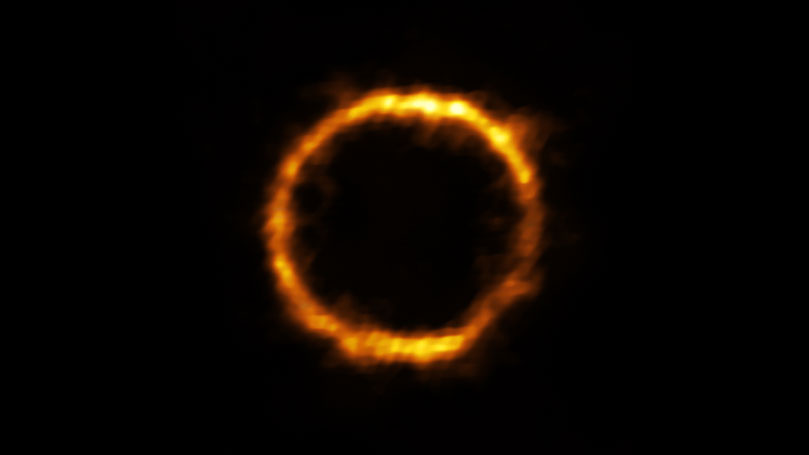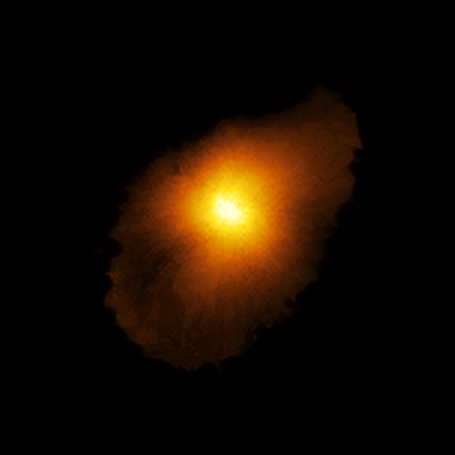A cosmic magnifying glass has revealed a Milky Way-like galaxy in the early universe that doesn’t conform to cosmologists’ expectations.

ALMA (ESO / NAOJ / NRAO) / Rizzo et al.
When astronomers look into the distant universe, the galaxies they have the best chance of seeing must be exceedingly bright to be seen from so far away. But cosmic magnifying glasses known as gravitational lenses make even ordinary galaxies visible from billions of light-years away.
Now astronomers have used such a lens to capture the light from a galaxy that shares some remarkable similarities to our own Milky Way Galaxy — a finding that could have profound implications for galaxy evolution.
Francesca Rizzo (Max Planck Institute for Astrophysics, Germany) and colleagues witnessed light that left a young, still-forming galaxy 12 billion years ago. That light traveled for 9 billion years before it passed by a foreground galaxy that, as chance would have it, sits right between the more distant galaxy and us. The foreground galaxy’s gravity bends the light and distorts its shape. As a result, from our perspective on Earth, the distant galaxy appears as a perfect ring: an Einstein Ring.
Rizzo’s team used the Atacama Large Millimeter/submillimeter Array (ALMA) in Chile to image the glow of this galaxy’s cool dust, as well as emission associated with its star forming gas. They then reconstructed the galaxy, showing what it would look like to ALMA if there were no galactic lens distorting its shape. It’s a tricky process, but the fact that the distorted galaxy is a complete Einstein ring helps, Rizzo says, as it leaves less wiggle room in the reconstruction.

ALMA (ESO / NAOJ / NRAO) / Rizzo et al.
The digitally restored galaxy is small — roughly 10 times smaller than the Milky Way — and furiously forming stars, at a rate about 100 times the star formation in our own galaxy. So far, so expected: Galaxies in the early universe were only beginning to grow, so astronomers would predict that they'd be small and bursting with new stars.
Nevertheless, the galaxy, which goes by the moniker SPT0418–47, is surprisingly like the Milky Way in its shape and behavior. Like our galaxy, it’s a disk galaxy with a bulge. And — quite unexpectedly — rotation largely directs its gas motions. Rotational motions dominate over random motions in this galaxy by a ratio of about 10:1. These results appeared August 12th in Nature.

ALMA (ESO / NAOJ / NRAO) / Rizzo et al.
Cosmological simulations have taught astronomers to expect fluffy disks in the early universe, with lots of other forces contributing to their gas motions besides rotation. For example, new stars give off radiation that pushes gas outward and supernovae blast gas away, too. Likewise, a gas-guzzling black hole at the galaxy’s center could make plasma jets that disrupt the rotation of gas around the galactic center. But such forces don’t seem to disrupt this galaxy; its disk is rotating as calmly as the Milky Way’s.
Making this comparison to cosmological simulations isn’t so simple, though, cautions Marcel Neeleman (Max Planck Institute for Astronomy, Germany). “It remains very difficult for cosmological simulations to actually measure the ratio of rotational motion to random motions,” he says. “To correctly measure this quantity for comparison with the data requires simulations to model the cold gas, which most simulations (including the TNG50 simulation quoted in this paper) do not do.”
That said, Neeleman thinks that if these findings can be replicated in a larger sample of galaxies in the young universe, we may indeed need to take another look at what we think we know about how galaxies evolve.
Cosmological simulations used to have galaxies forming too many stars early on, Neeleman explains. Current simulations solve that problem by including additional known processes, like the aforementioned gas-guzzling black hole and the blowback associated with newborn stars. Such feedback would prevent the gas from making too many stars. It would also stir up the gas, making it turbulent.
“However, if the gas is not turbulent, this is not the reason why simulations without feedback produce too many stars early on,” Neeleman says. Maybe star formation and feeding black holes still play a role, but don’t stir up the cooler gas. Or maybe the role of feedback isn’t as important early on as we thought.
A Galaxy's Fate
We're seeing a baby picture of this galaxy when the universe was less than 2 billion years old. But even galaxies must age. We'll never see this galaxy reach the present-day, but we can be sure it'll look vastly different.
Our current picture of galaxy evolution says this galaxy will eventually run out of star-forming material, undergo some mergers with its neighbors, and end up as a massive elliptical with only old, red stars to show for the passage of cosmic time. (The Milky Way exists in a very different universe, Rizzo says, and will avoid this "red and dead" fate.)
Nevertheless, if this galaxy and others like it end up changing our views of galaxy evolution, it'll be interesting to see how these predictions change.
 27
27









Comments
Caio Soraggi
August 20, 2020 at 7:22 pm
Good morning, friends! I have some doubts!
1) Why can we never see this galaxy as it is today?
2) How much can we "go back in time" and see the young universe?
3) If we build larger telescopes, can we see the Big Bang?
Thank you!
You must be logged in to post a comment.
Monica YoungPost Author
August 20, 2020 at 8:54 pm
Hi Caio,
Good questions! When we look into space, we're looking back into time. So if we look at this galaxy, we're seeing as it was 12 billion years ago. There's no way for us to see it as it is today. As we look farther and farther into space, we see things from earlier and earlier in time. At some point, we reach the cosmic dark ages, the time before stars and galaxies formed. Even then, we can still see a bit farther back if we look not at stars and galaxies but the afterglow of the Big Bang, known as the cosmic microwave background. That was emitted 380,000 years after the Big Bang, when the universe cooled enough to set photons free. Before this time, photons were entangled with matter, so no, we can never see as far back as the Big Bang — which is too bad, it would answer a lot of questions!
You must be logged in to post a comment.
urbo
August 21, 2020 at 7:15 pm
I just finished reading Dr. Katie Mack’s The End of Everything. She has a really interesting discussion of gravitational lending. It is fascinating to see results of the technology in cosmology! Particularly to those of who are non-physistics.
You must be logged in to post a comment.
Caio Soraggi
August 23, 2020 at 1:24 am
Thank you very much for the explanations, Monica.
Do you think that with the new James Webb telescope, we will be able to reach the limit of the observable universe? 🙂
You must be logged in to post a comment.
Yaron Sheffer
August 24, 2020 at 10:58 am
We have already reached the limit of the observable universe, at least with microwave radiation. As Monica wrote, space was opaque up till the universe was 380,000 years old, or at redshift of about 1100. Astronomers are hoping that with JWST they could observe galaxies at redshift of 10 or 20. It took millions of years after the Big Bang to assemble the first stars and galaxies, and there is not much to observe (optically, mainly in the IR) before that time.
You must be logged in to post a comment.
Caio Soraggi
August 25, 2020 at 12:41 am
Amazing. Thanks, Yaron!
You must be logged in to post a comment.
Uwq_1rRhIcDO
August 21, 2020 at 1:44 am
> The Milky Way exists in a very different universe, Rizzo says,
> and will avoid this "red and dead" fate.
So, the Milky Way will never burn all of its hydrogen into heavier elements?
What eventually happens to the galaxies in our "very different universe" when?
You must be logged in to post a comment.
Yaron Sheffer
August 24, 2020 at 11:21 am
What she means is that the small galaxy will convert all its gas into stars, which will still be composed mostly of hydrogen. The Milky Way has plenty of gas, and only moderate oomph of star formation, so it has not turned from a spiral galaxy into an elliptical...yet. It may happen in the far future, and perhaps after we are done colliding and merging with Andromeda down the road...
You must be logged in to post a comment.
Uwq_1rRhIcDO
August 25, 2020 at 12:37 am
Thank you for the detailed explanation. It makes sense now.
You must be logged in to post a comment.
Thomas Aquinas
August 21, 2020 at 3:01 am
If we have spectral analyses and determine that early galaxies could be similar to the Milky Way or M31, that would change everything. If heavy elements were available for our type of solar system and terrestrial planets, then it's possible civilizations exist(ed) that were millions, or billions, of years ahead of us. This is not possible given what we believe in stellar evolution... If it were true, then 'they' could well have come here and might even still be here. But beings millions or billions (sorry Carl) ahead of us would not be mere astronauts but more like gods...
You must be logged in to post a comment.
Anthony Barreiro
August 21, 2020 at 1:32 pm
My understanding is that this galaxy is similar to our own in so far as it is a rotating disk with a central bulge. They didn't find heavy elements, terrestrial planets, or the ancestors of godlike extraterrestrials.
You must be logged in to post a comment.
Yaron Sheffer
August 24, 2020 at 10:38 am
Even this description is too optimistic. There is really nothing Milky-Way-like about this galaxy far far away. It is 10 times smaller than ours! Sure, it has a rotating disk and even a small bulge. But the mention of our galaxy is misleading, especially if the authors predict that the small galaxy will eventually evolve into an eliptical galaxy---this is as un-Milky-Way-ish as you can get!
You must be logged in to post a comment.
Anthony Barreiro
August 24, 2020 at 7:55 pm
Both SPT0418–47 and the Milky Way are rotating disks with central bulges. They are similar in that regard. It is remarkable to find a galaxy of this morphology at such a high redshift, and it is an astounding technical accomplishment to be able to discern such features over such a distance. The galaxies are different in other respects, but the newsworthy aspect is their similarity.
You must be logged in to post a comment.
Yaron Sheffer
August 26, 2020 at 10:16 am
We are in full agreement, but I think the authors should not have compared it to our galaxy. Sure, it helps the ratings to mention our Milky Way, just look at how many comments we have here 😉 But about half of billions and billions of galaxies in this universe have rotating disks, it's really not copyrighted by the Milky Way!
You must be logged in to post a comment.
Monica YoungPost Author
August 31, 2020 at 9:49 am
There are two respects in which this galaxy is similar to the Milky Way. As Anthony mentioned, it is a rotating disk with a spheroidal bulge at the center. I can count the other examples of rotating disks (and disk candidates) on one hand, so that in itself is noteworthy. But also, the disk - as explained in the article - is not as fluffy as expected, which is to say, it doesn't have the random motions that you'd expect for an early galaxy. In that respect, it's also similar to the Milky Way - in our galaxy, rotational motions also dominate over random ones.
You must be logged in to post a comment.
Thomas Aquinas
August 31, 2020 at 3:28 am
Thanks for the constructive criticism. They did use the term 'dead ringer'. Plus, note I used conditional words like ‘if’ and even more doubtful words like ‘not possible’. Of course, our knowledge of the early universe is so skeletal that we still might find anomalies. Finally, the percent of the life-time of a main sequence star is such that civilizations anywhere in the universe might have millions of years' head-start on us.
You must be logged in to post a comment.
Anthony Barreiro
August 21, 2020 at 1:30 pm
Most of Rizzo et al.'s Nature article is behind a paywall. The full article is freely available through the European Southern Observatory:
https://www.eso.org/public/archives/releases/sciencepapers/eso2013/eso2013a.pdf
It's all over my head, but some of the figures are interesting.
Did ALMA detect a signal from the foreground lensing galaxy that has been removed through image processing, or is the foreground galaxy not visible at these wavelengths?
By the way, at right ascension 04h 18m 39s and declination –47 degrees 51.9 arcminutes, this ancient galaxy is in the southern sky, near the borders of Horologium, Caelum, and Dorado.
You must be logged in to post a comment.
Monica YoungPost Author
August 21, 2020 at 6:10 pm
Anthony, I don't know the answer (the paper doesn't really talk about the foreground galaxy much), but I suspect it's not visible at these wavelengths. ALMA images emission from cold gas and star formation at high redshifts, and those wavelengths have stretched as they pass through expanding space. At the lower redshifts of the foreground galaxy, there might not be much to see at these millimeter-ish wavelengths.
You must be logged in to post a comment.
Anthony Barreiro
August 21, 2020 at 7:45 pm
Thanks Dr. Young, that was my guess too. The ESO article was so technical that I couldn't even skim it for a reference to the foreground galaxy.
You must be logged in to post a comment.
Yaron Sheffer
August 26, 2020 at 10:10 am
Thanks, Anthony! This link was super helpful for reading the actual paper 🙂
You must be logged in to post a comment.
Mr.Claude
August 21, 2020 at 5:32 pm
We thought the world was flat, then found out it was curved. We thought space was flat then found out gravity can curve that. So maybe if we could see this galaxy as it is today, we may be gazing upon ourselves!
You must be logged in to post a comment.
BlueJayW
August 21, 2020 at 7:57 pm
I registered an account just to reply to this comment because I was so excited by someone else having this thought. My science professor gave a lecture one afternoon on cosmic topology, and one of the possibilities he presented was the universe being a 3D sphere, which would mean travelling in one direction would bring you back to your starting point eventually. He said that his own thesis experiment in college was to study the cosmic microwave background for repeating patterns that could point at that being a possibility. As soon as I heard this galaxy was discovered that was my first thought.
You must be logged in to post a comment.
Yaron Sheffer
August 24, 2020 at 11:13 am
As much as I'd be thrilled to finally gaze directly at my back and give it a good scrub, this option of a curved universe is no longer valid, at least according to Planck results. It found that the universe is totally flat, thus precluding views of ourselves 🙁
You must be logged in to post a comment.
stargate
August 21, 2020 at 11:03 pm
The reconstruction of a distant galaxy's shape and dynamics from its gravitational lense is very exciting - perhaps second only to the discovery of gravitational waves.
But the models that attempt to explain the early structural dynamics of these galaxies and their evolution almost always ignore the role of galactic magnetic fields.
Especially in early compact dense galaxies, the role of magnetic pressure can be shown to be as important as radiation pressure. There is also the coupling of the magnetic fields of stars to the rotating galactic magnetic fields that permeate this space. This coupling will certainly affect the rotation of the galactic medium which is itself an ionized plasma.
Finally, the massive rotating black hole surmised to exist at the galactic center may have a massive magnetic field as well that will couple to the galactic medium and impact its dynamics and evolution.
Inclusion of dynamic magnetic fields in early galaxy evolution is a difficult theoretical problem but one which nevertheless should be addressed.
You must be logged in to post a comment.
Uwq_1rRhIcDO
August 22, 2020 at 3:55 am
Aren't black holes prohibited from having magnetic field by the no-hair theorem?
You must be logged in to post a comment.
stargate
August 22, 2020 at 9:23 am
True - but black holes can concentrate external magnetic fields in their accretion disk right up to the event horizon which then act as if they are intense magnetic fields being generated by the black hole as seen by the rest of the galaxy. But in principle you are correct.
You must be logged in to post a comment.
Uwq_1rRhIcDO
August 25, 2020 at 1:42 am
Thank you. I was reading it too literally.
You must be logged in to post a comment.
You must be logged in to post a comment.